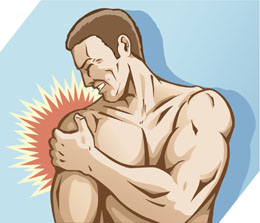For starters, a pulled muscle is extremely painful, and you need to treat the area with absolute caution so as to avoid aggravation. This Buzzle post lists out the symptoms of a pulled muscle in different parts of the body.

Our bone structure or skeleton is held in its proper position by the muscles present in our body. These muscles are made up of tissues and fibers. In case of a sudden, uncoordinated action, these fibers and connective tissues can be overstretched, resulting in the breakage of tiny muscle cells. This in short, is called a muscle pull. This excessive strain may be caused due to the absence of a proper warm-up prior to exercising.
Symptoms of Pulled MusclesWhen there is a muscle pull in any part of your body, the first symptom you feel is immediate pain in that area, which is followed by a swelling. The symptoms of this condition are distinguished by the severity of the pull and are as follows:
- Swelling or inflammation
- Pain in the area on application of pressure
- Limited movement of the muscle
- Associated joints and muscles are also affected as pain can be experienced there as well
- Excruciating pain is observed immediately
- Affected muscle becomes weak
- The pulled muscle becomes hard and you get a feeling of stiffness in that area
Every part of our body has muscles, so a pull can occur absolutely anywhere. Some of the body parts that are prone to a muscle pull are the back, chest, and legs.
Symptoms in the Back
- Stiffness of muscles
- Swelling
- Spasms or contractions in back muscles
- Excruciating pain in the strained area
- Surrounding muscles also exhibit pain and spasms
- Sharp, burning, or blinding pain
- A hot sensation can be experienced in the affected area
Symptoms in the Chest
Pulled chest muscle signs are observed within 24 hours of the injury.
- A major swelling of the tendons is observed
- Pectoral tendinopathy, which is the extreme stage of damage to the chest muscles is also a very commonly observed symptom
- If the pain is not immediate, your arms and your chest may start aching after a duration of 6 to 8 hours
- You may also experience pain while moving your upper body.
Symptoms in the Legs
The leg comprises a variety of muscles and as they are associated with running and physical stress, there are more chances of strain in the leg area. Symptoms include:
- The area where the pull has occurred, turns black and blue in color
- Tender swelling and muscle pain is observed after contracting the muscle
- A loss of muscle function can also be seen in the affected area
- A bruise, depression, or some other type of disfiguration is observed
- A certain hardness develops at the site. These are some of the visual symptoms
- A popping sound can be heard on moving the affected area
- The calf muscle stiffens and aches on movement
- If this injury is left untreated, the symptoms can lead to further worsening of the affected muscle.
Causes and TreatmentCommon causes of this injury include over stretching while lifting heavy loads, accidents, or an incorrect posture while sitting, sleeping, or bending. The major causes of a chest or leg muscle pull can be excessive strain while running, jogging, or playing any sport. Gastrocnemius (calf muscle), plantaris, hamstring, and quadriceps are leg muscles where spasms or pulls can occur very often. Intense workouts can also lead to a spasm in the chest.
Pulled muscles can be treated by simple remedies like applying ice packs on the strained area, or by applying heat to the affected area for about 20 minutes everyday and taking anti-inflammatory medication. Adequate amount of rest is the most important treatment for a pulled muscle.
Disclaimer:
This Buzzle article is for informative purposes only, and should not be used as a replacement for expert medical advice.


 Our bone structure or skeleton is held in its proper position by the muscles present in our body. These muscles are made up of tissues and fibers. In case of a sudden, uncoordinated action, these fibers and connective tissues can be overstretched, resulting in the breakage of tiny muscle cells. This in short, is called a muscle pull. This excessive strain may be caused due to the absence of a proper warm-up prior to exercising.
Our bone structure or skeleton is held in its proper position by the muscles present in our body. These muscles are made up of tissues and fibers. In case of a sudden, uncoordinated action, these fibers and connective tissues can be overstretched, resulting in the breakage of tiny muscle cells. This in short, is called a muscle pull. This excessive strain may be caused due to the absence of a proper warm-up prior to exercising.